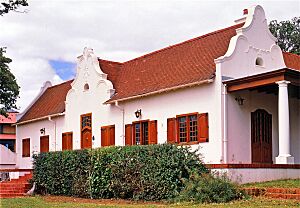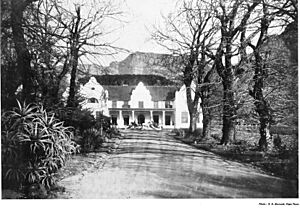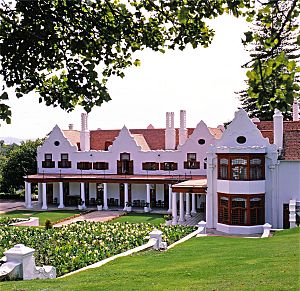Groote Schuur facts for kids
Quick facts for kids Groote Schuur |
|
|---|---|
 |
|
| Location | Rondebosch, Cape Town, South Africa. |
| Built | 18th century |
| Architect | Sir Herbert Baker (19th century refurbishment) |
| Architectural style(s) | Cape Dutch |
| Lua error in Module:Location_map at line 420: attempt to index field 'wikibase' (a nil value). | |
Groote Schuur (which means "big shed" in Dutch) is a famous estate in Cape Town, South Africa. It has a long and interesting history. Today, it is a museum that you can visit by appointment.
This estate started in 1657. Back then, it was owned by the Dutch East India Company. They used part of it as a granary, which is a building for storing grain. Later, the farm and its farmhouse were sold to private owners.
The estate stayed in private hands for many years. In 1891, a very important person named Cecil Rhodes leased it. He then bought it in 1893 for £60,000. Rhodes hired a famous architect, Sir Herbert Baker, to redesign and improve the house.
Contents
A Historic Home's Transformation
Groote Schuur is built in the Cape Dutch style. It is located in Rondebosch, on the slopes of Devil's Peak. This mountain is part of the larger Table Mountain range. The original building was part of the Dutch East India Company's granary from the 1600s.
Rebuilding After a Fire
A big fire in 1896 damaged much of the original house. After the fire, the traditional thatched roof was replaced with stronger Welsh slates. Cecil Rhodes gave Sir Herbert Baker a lot of freedom with the design.
Rhodes did not like machine-made items in his home. He asked for them to be replaced with handmade brass and bronze pieces. Baker changed the front of the house and added a long porch at the back. He also built a new section. This new part included a billiard room and a large master bedroom upstairs. The bedroom had a big bay window looking out over Devil's Peak. A grand hall with a huge fireplace was also added.
Inside the house, you can see four beautiful 17th century tapestries from Flanders. These tapestries show different parts of the world: America, Africa, Europe, and a scene representing Victory.
Furnishing and Gardens
Sir Herbert Baker also helped choose the furniture for Groote Schuur. At first, Rhodes had modern furniture from London. But Baker encouraged him to collect more traditional Cape furniture. This started Cecil Rhodes' collection of old colonial furnishings.
Rhodes wanted the gardens to be full of "masses of colour." Around the house, there were many roses, hydrangeas, cannas, bougainvilleas, and fuchsias. Further away, on the slopes of Devil's Peak, Rhodes kept wild animals. These included antelopes, zebras, elands, wildebeest, and ostriches.
Cecil Rhodes was known for being a very welcoming host at Groote Schuur. He used the house for both business and politics, as well as his home. He often held dinner parties and meetings on the porch. Sometimes, as many as fifty people would join him.
Important People and Events

The Woolsack Guest House
"The Woolsack" is another house that was once part of the Groote Schuur estate. In 1980, it was given to the University of Cape Town. Today, it is used as student housing. The Woolsack is close to Groote Schuur.
Cecil Rhodes used The Woolsack as a guest house. A famous guest was the British poet and writer Rudyard Kipling. He stayed there for his winter holidays between 1898 and 1908. Kipling, known as the "Poet of the Empire" at the time, became friends with Rhodes. During his visits, he wrote poems and newspaper articles. These supported the British during the Second Boer War and the creation of the Union of South Africa.
A Home for Leaders
From 1910 to 1984, Groote Schuur was the official Cape Town home for the Prime Ministers of South Africa. It continued to be a presidential residence for P. W. Botha and F. W. De Klerk. However, P. W. Botha chose to live in another residence called Westbrooke.
In May 1956, Time magazine reported on a party held at Groote Schuur. This party was for South Africa's Prime Minister Johannes Strydom. It celebrated his success in a parliamentary campaign. This campaign aimed to continue policies that favored the white population in South Africa. A large group of supporters drove to Groote Schuur. They sang old songs from the Boer War. A female member of parliament, Mrs. M. D. J. Koster, thanked the Prime Minister. Strydom responded by saying the struggle for their goals must continue.
The Groote Schuur Minute
The building became famous for a very important event on May 4, 1990. This was when the historic "Groote Schuur Minute" was signed. Nelson Mandela, representing the African National Congress (ANC), and F. W. De Klerk, who was the State President, signed this document.
The "Groote Schuur Minute" was a promise between the two groups. They agreed to work towards ending violence and intimidation. They also committed to a peaceful process of negotiations. A special group was formed to help with this. They looked into giving temporary protection to ANC members. They also advised on how to release political prisoners. And they made recommendations on what counted as a political offense.
After Nelson Mandela became President of the Republic of South Africa, the Genadendal building (formerly Westbrooke) became the official presidential home in Cape Town. Groote Schuur is now a museum. You can visit it by making an appointment.
See also
- Genadendal Residence
- List of Castles and Fortifications in South Africa
- Highstead, official residence of the Deputy President



